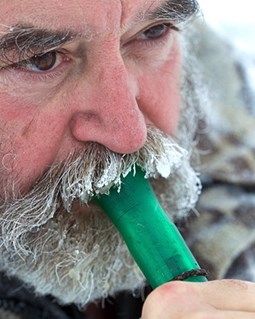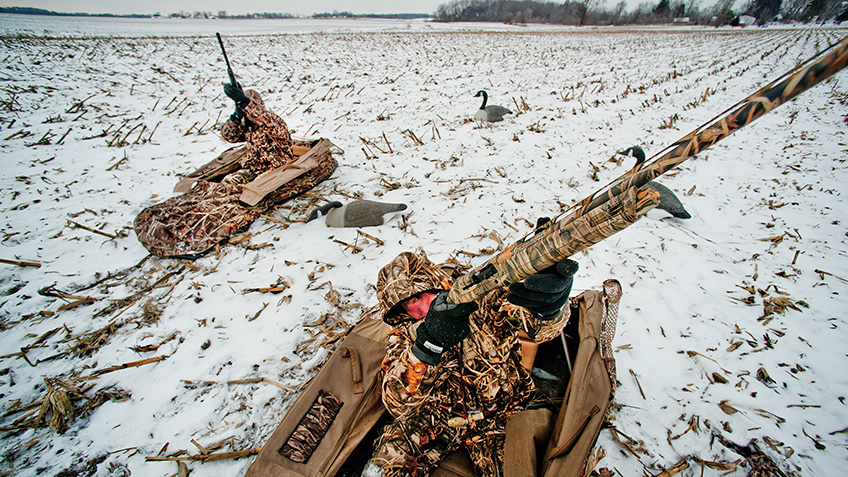
The perfect decoy spread. The invisible blind. The killer call. Duck hunters have been seeking the magic pill for at least the last 150 years. And I think I may have found it. Or maybe two. Or three …
Of course, it’s not a magic pill at all. It’s a magic place. To find it we must also learn to scan for perfect weather and the perfect date.
The Perfect Place
I know. This is the hardest part, but the most productive if you can pull it off.
We’ve all seen that private pond along the highway where all the mallards pile up during the season because no one gets to hunt it. We’ve heard of those hot springs that stay open all winter, ducks smothering the water like lily pads. And who doesn’t want to discover that North Dakota Waterfowl Production Area pothole seething with ducks out in Guesswhere County so isolated that not even Google search can find it?
Sigh. We all know about those perfect places where waterfowl whiffle in like autumn leaves. But few of us have permission to hunt them. So we buy more decoys, blow more calls and re-patch the camouflage on the old blind. Hope springs eternal, but uncovering the perfect spot gets more birds.
“What’s over there?” I asked Ben Cole last September. He, Brad Fenson and I were crouched beside a brush-lined pond in the Saskatchewan parklands where the locals had taken limits just two days earlier. Yet all this day’s limits were piling in a half-mile north.
“I don’t know,” Cole said, “but they’re pouring in there. Wait, here’s a bunch heading right toward us. I’ll bet we can talk them in.” Whereupon he and Fenson unlimbered their Sure-Shot calls and laid down enough hen talk to almost convince me to jump into our decoys. But the ducks didn’t circle—didn’t so much as bend a primary feather in our direction as they bored toward that haven to the north.
“What?” Fenson asked rhetorically. “Are they serving corn-off-the-cob up there?”
Probably not. Just uninterrupted solace. And once a few flocks start advertising their newfound paradise, word gets out. The best caller in the world can’t talk down a flock with somewhere better to go. Frustration station. We work our butts off making everything perfect, only to watch duck after duck plane into that hole 400 yards behind us.
Situations like this are the bane of waterfowl hunting. Here in the opening decades of the 21st century, we must spend as much time hunting for a place to hunt as hunting the place we find. But it’s mandatory. So …
Don’t settle for your same old spot. Look. Listen. Map. Fly. If birds consistently land just beyond those trees, try to determine why. Fly it with a camera drone if you have to (and if it’s legal). Flooded grain field? Beaver pond surrounded by mast trees? Can you find a way to hunt that spot? Given today’s stiff competition for hunting rights, most of us assume every place is leased or owned by someone who does not allow hunting. That’s not always the case.
Most of us like to blow a call because, well, it’s something we can do. And it fulfills our on-stage rock star fantasies to some degree. But trust me, the ducks and geese might not share our enthusiasm.
Even pros like Sure-Shot Game Calls president Charles Holder will “slow the blow” until birds show they need it. “If they’re approaching, just sit still,” he told me. “At most, give them a feeding chuckle or two. If they appear to be going away, try a comeback call or lonesome hen. If flocks are passing high, by all means try the hail call, but if flock after flock ignores it, you’re probably just in the wrong spot.”
Despite that sage advice, don’t be afraid to call, either. Sometimes birds really do need a good talking to before they pay attention to you. Try calling aggressively at a few flocks to gauge how they respond. During one North Dakota hunt my hosts insisted calling didn’t work in that area. “No one calls much.” That suggested the flocks buzzing around us were probably open to something different. I called and we immediately worked birds right into our set. Sometimes all you have to do is what everyone else doesn’t do.
I once spotted ducks on a small pond along a county road. Local hunters insisted the landowner was a hard case who wouldn’t let anyone hunt. But I hadn’t grown up there, so as a complete stranger, I introduced myself to this hard-case farmer and asked if I could hunt. “Sure,” he said. “But only weekday mornings.” The birds were so accommodating that I took limits while using just six decoys and a 20-gauge.
If you can’t find the landowner nearby, check at the county government offices. They should have public records on who owns the ground. Next comes the hard part: screwing up your courage to ask. Just do it. Be polite, down-home friendly, personable, but honest. Offer to share, trade, or take the landowner or his kids hunting. This is about salesmanship. You’re selling yourself.
Sometimes gaining access to a hotspot is as simple as breaking inertia and moving.

“That’s the third flock that’s ignored our decoys and landed back in those reeds,” my buddy Brad said one November on a public hunting wetland. “Maybe we should move.”
“Pick up all these decoys?” I asked. “Naw, we can pull a few flocks in.”
Except we couldn’t. After two more flocks gave us the cold shoulder, we moved, discovered a “secret” hole deep in an expanse of impenetrable reeds, and flushed several hundred mallards, gadwalls and wigeon from it. But our move was a bit too late. We decoyed two small flocks before the morning flight was over, but we’d learned our lesson: Set up where the birds want to go—and do it early!
Perfect Weather
Here’s a secret weapon that doesn’t involve buying any gadgets. Most of us know this, but feel powerless to do anything about. I mean, if our scheduled Saturday hunt coincides with 80 degrees and no breeze, what are we going to do? Well, how about rearranging our lives to be more flexible? Trade your boss a Saturday off for a Thursday or Friday.
Even better is flex scheduling. Arrange work so you can escape nearly any day and then pick a good one based on weather forecasts. Low pressure, snow, wind. You know the right conditions.
One job I worked for three years offered flex scheduling. We could take off a half day or even a few hours as long as we made them up another day. One blustery November Wednesday, with a blizzard just moving in, my hunting buddy Harvey sidled into my work space and hissed, “Mallards on the deck.” I quietly checked out and the two of us drove to a “pass” where wind-blown mallards flew low from a roosting lake to bordering cornfields. At 3 p.m. with 25-mph winds and snow beginning to fall, they nearly took our caps off as they passed. We limited in less than an hour.
Don’t assume bad weather is always best. This harks back to scouting and paying attention.
Here’s the tactic I really need to work on: shooting well. Given the few good shooting days we are lucky enough to get, it’s a waste to screw them up with poor shooting. Invest time and shells in honing your skills on clays thrown at a variety of angles, but especially high, crossing and incoming. Use your waterfowling gun, not your sporting clays gun. Light target loads are good enough, especially if muzzle velocity nearly matches your field loads.
Over the years, Harvey noticed that calm, sunny days in mid-November were actually more productive for decoying mallards than windy, cloudy ones. As soon as we saw or heard of big migrating flocks moving in, we hit his proven blind location on a public hunting area midmorning, midweek, in bluebird conditions. Conventional wisdom kept most competition home waiting for “duck” weather.
Harvey and I napped in the boat until about 9:30 a.m. “Should start anytime now,” Harvey said. Within 10 minutes flickering flocks appeared near the stratosphere. Harvey hit a loud, long high-ball and the flickers started spiraling down—right into our laps. The harsh light gave us extra shadows in which to hide.
“What’s the deal?” I asked when the smoke settled.
“They’re out feeding at dawn,” Harvey explained. “And some are just coming in after an all-night migration flight.”
Perfect weather. Perfect “scouting.” Perfect timing.
Perfect Date
Duck and goose hunting is regulated into fairly tight seasons. Nevertheless, within the framework of open dates, not all seasons are created equal.
Most of us see an advantage in opening weekend when we hope to find young, locally bred ducks as yet unaccustomed to hunting pressure. Often still in pin feathers, they don’t look like much, but they sure taste like much. And they decoy as if mama abandoned them too early. But after a day or two of noisy harassment, they wise up. Rather than burn vacation days on a low-percentage hunt, why not wait until the first waves of northern migrants come in? Even though they’ve been called, decoyed and shot at from the Arctic to Arkansas, they’ll be most accommodating on their first day or two in your neck of the woods. And they’ll be sorting out which wet areas are the safest on which to sit, so flights are frequent and decoying productive.
In most areas, these migration flights are fairly consistent unless unusually warm weather keeps water open farther north. Changes in forage crops are more gradual. Most of the northern “short stopping” was established years ago when vast new reservoirs and irrigated corn fields were put in. But if these get iced over or snowed over, new birds should be moving your way. Keep your finger on the migration news via Ducks Unlimited’s online Waterfowl Migration Map.
A good way to figure out when most northern flights typically reach your area is to consult your state fish-and-game agency. They usually have statistics on average arrival dates for ducks and geese. These can vary by a week, sometimes several weeks due to extreme weather, but they offer a reasonable starting point for planning your hunting dates long term.
Looking for more waterfowl hunting tips and tactics? Check out the following articles:
• 21st Century Duck Hunting Tips
• Duck Commander Q&A
• 7 Ways to Prep for Waterfowl Season
• How to Hide Your Layout Blind
• Tips and Tactics for Hunting Wary Waterfowl
• How to Build a Portable A-Frame Blind for Under $100
• Duck Hunting Tactics for Unusual Weather
• How to Outsmart Late-Season Geese
• Know-How: A Duck Spread with Serious Drawing Power
• How to Hunt Ducks on Small Water
• How to Build the Perfect Snow Goose Shotgun
• 6 Tips for Identifying Waterfowl
• How to Fight Decoy Frost
• Know-How: Ducks in Crowded Places
• How to Hit More Ducks
• A Beginner’s Guide to Waterfowl Hunting
• Know-How: Stop Geese Cold
• Tips for Early-Season Waterfowl Hunting
• How to Breast a Duck in Under 90 Seconds
• The Evolution of Waterfowl Camo
• How to Avoid Waterfowl Calling’s Biggest Mistake
• 10 Ways to Improve Your Decoy Spread
• How to Build a Better Wood Duck Box
• Waterfowling on the Cheap: Decoys



































